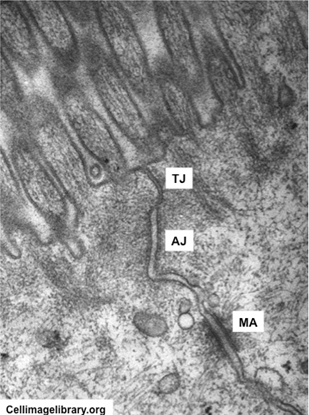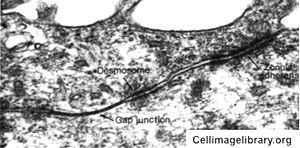|
Intercellular junctions and cell-extracellular
matrix junctions
 Epithelial
cells attach to their neighbors and to the underlying basement
membrane using specialized types of intercellular junctions and
cell-extracellular matrix junctions, respectively. These junctional
complexes also link the cytoskeletons of neighboring epithelial
cells, allowing them to coordinate their functions. Epithelial
cells attach to their neighbors and to the underlying basement
membrane using specialized types of intercellular junctions and
cell-extracellular matrix junctions, respectively. These junctional
complexes also link the cytoskeletons of neighboring epithelial
cells, allowing them to coordinate their functions.
Take a look at the three main types of
intercellular (cell-to-cell) adhesion junctions in this TEM image of intestinal
epithelium at the right:
- Tight or occluding junctions-
composed of occludins and claudin proteins, these junctions are
located in the lateral plasma membrane near the apical surface,
forming a tight seal between the cells to separate the luminal
environment from the underlying connective tissue
- Adherent junctions or zonula
adherens- composed of E-cadherin and catenin proteins, these
junctions are located below the tight junctions, where they
connect the actin cytoskeletons of neighboring cells and support
the tight junctions
- Desmosomes or macula adherens-
composed of cadherin family proteins, these junctions form
spot-like welds, connecting the intermediate filament networks
of neighboring cells to provide strong structural support to the
epithelium.
 Epithelial cells also directly
communicate with their neighbors through gap junctions (Nexus).
These are small channels composed of connexin proteins located
in the plasma membranes of neighboring cells. Gap junctions
allow small molecules such as ions and metabolites (nucleotides,
sugars, and amino acids) to move between cells. In this TEM
image of a gap junction, notice how the plasma membranes of the
neighboring cells are in direct contact, allowing for
intercellular communication. Epithelial cells also directly
communicate with their neighbors through gap junctions (Nexus).
These are small channels composed of connexin proteins located
in the plasma membranes of neighboring cells. Gap junctions
allow small molecules such as ions and metabolites (nucleotides,
sugars, and amino acids) to move between cells. In this TEM
image of a gap junction, notice how the plasma membranes of the
neighboring cells are in direct contact, allowing for
intercellular communication.
Next are cell-to-extracellular
anchoring junctional complexes.
|